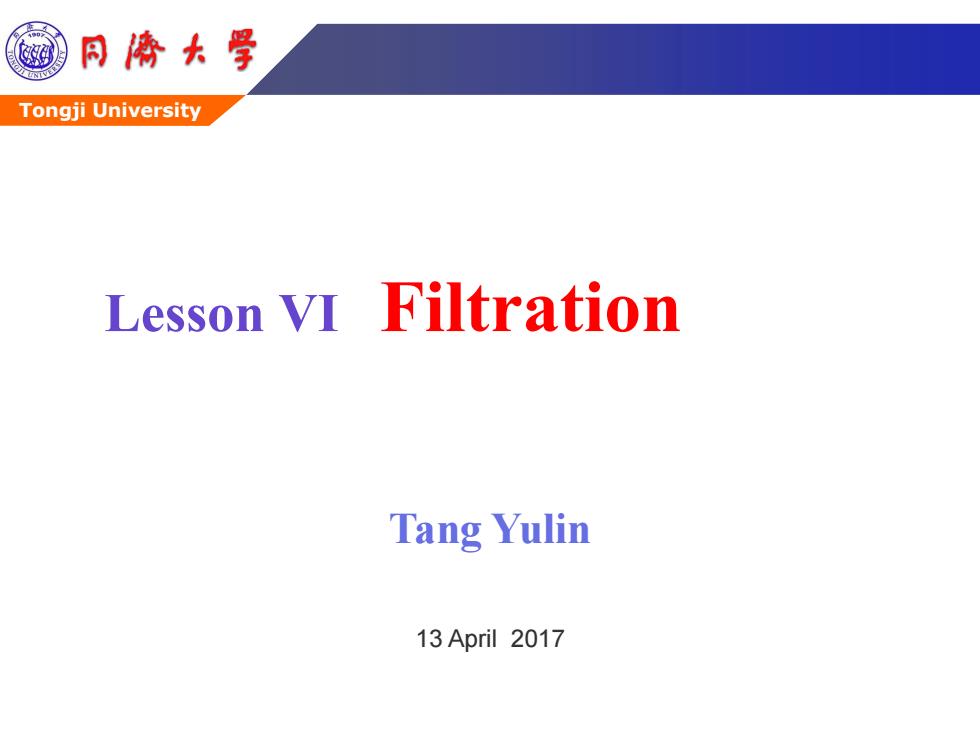
同©大学 Tongji University Lesson VI Filtration Tang Yulin 13 April 2017
Tongji University Lesson VI Filtration Tang Yulin 13 April 2017
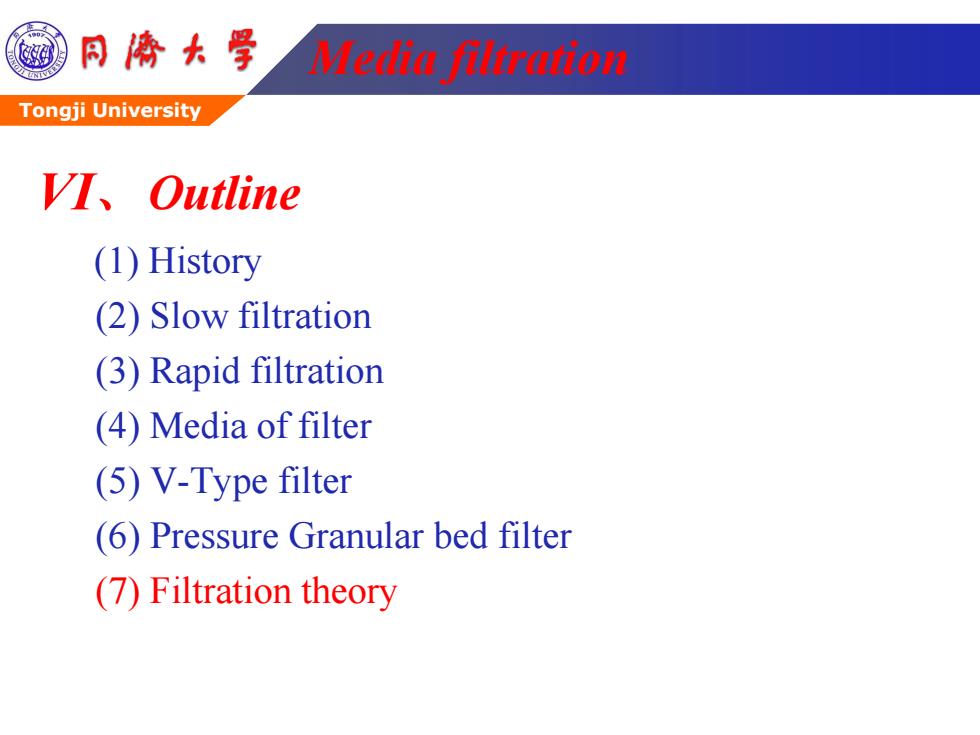
同瘠大学 Mediaion Tongji University VI、Outline (1)History (2)Slow filtration (3)Rapid filtration (4)Media of filter (5)V-Type filter (6)Pressure Granular bed filter (7)Filtration theory
Tongji University VI、Outline (1) History (2) Slow filtration (3) Rapid filtration (4) Media of filter (5) V-Type filter (6) Pressure Granular bed filter (7) Filtration theory Media filtration
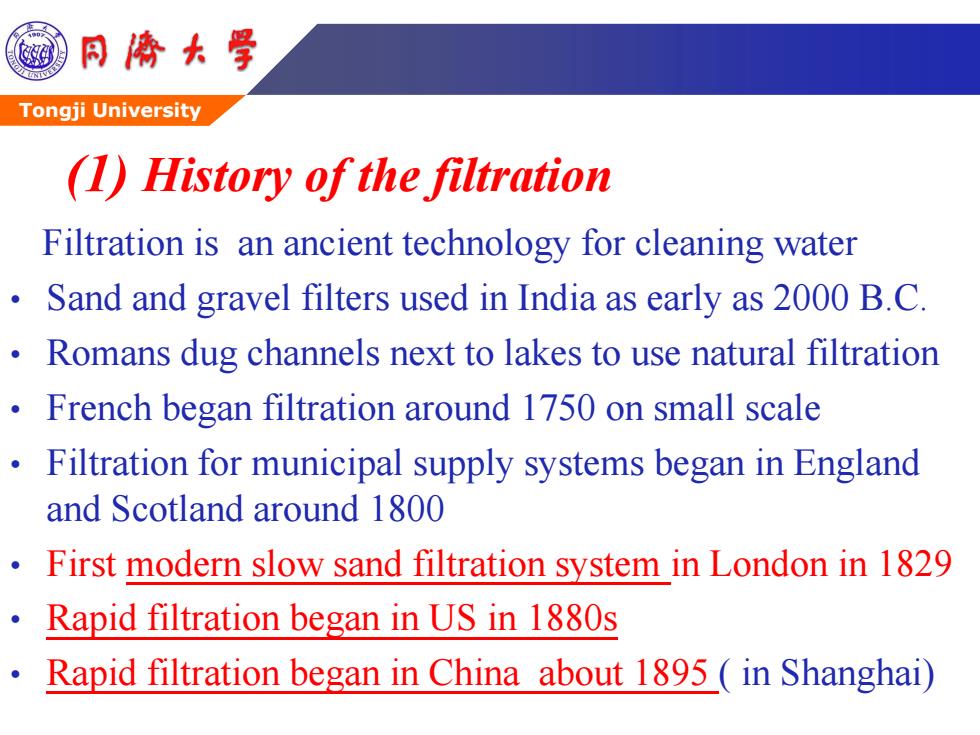
同©大学 Tongji University (1)History of the filtration Filtration is an ancient technology for cleaning water Sand and gravel filters used in India as early as 2000 B.C. Romans dug channels next to lakes to use natural filtration French began filtration around 1750 on small scale Filtration for municipal supply systems began in England and Scotland around 1800 First modern slow sand filtration system in London in 1829 Rapid filtration began in US in 1880s Rapid filtration began in China about 1895 in Shanghai)
Tongji University (1) History of the filtration Filtration is an ancient technology for cleaning water • Sand and gravel filters used in India as early as 2000 B.C. • Romans dug channels next to lakes to use natural filtration • French began filtration around 1750 on small scale • Filtration for municipal supply systems began in England and Scotland around 1800 • First modern slow sand filtration system in London in 1829 • Rapid filtration began in US in 1880s • Rapid filtration began in China about 1895 ( in Shanghai)

同©大学 Tongji University (2)Slow filtration This is the oldest form of filters,with fine sand loaded at low rate,0.05-0.2 m/hour. Slow sand filter treat the raw water by physical straining and biological degradation. There are 3-5 ft sand and form a layer of organic material and micro biofilm in the surface.Every few weeks or months,the top layer will be scrapped. This is a simple operation and no chemicals ones for small systems
Tongji University (2) Slow filtration This is the oldest form of filters, with fine sand loaded at low rate, 0.05-0.2 m/hour. Slow sand filter treat the raw water by physical straining and biological degradation. There are 3-5 ft sand and form a layer of organic material and micro biofilm in the surface. Every few weeks or months, the top layer will be scrapped. This is a simple operation and no chemicals ones for small systems
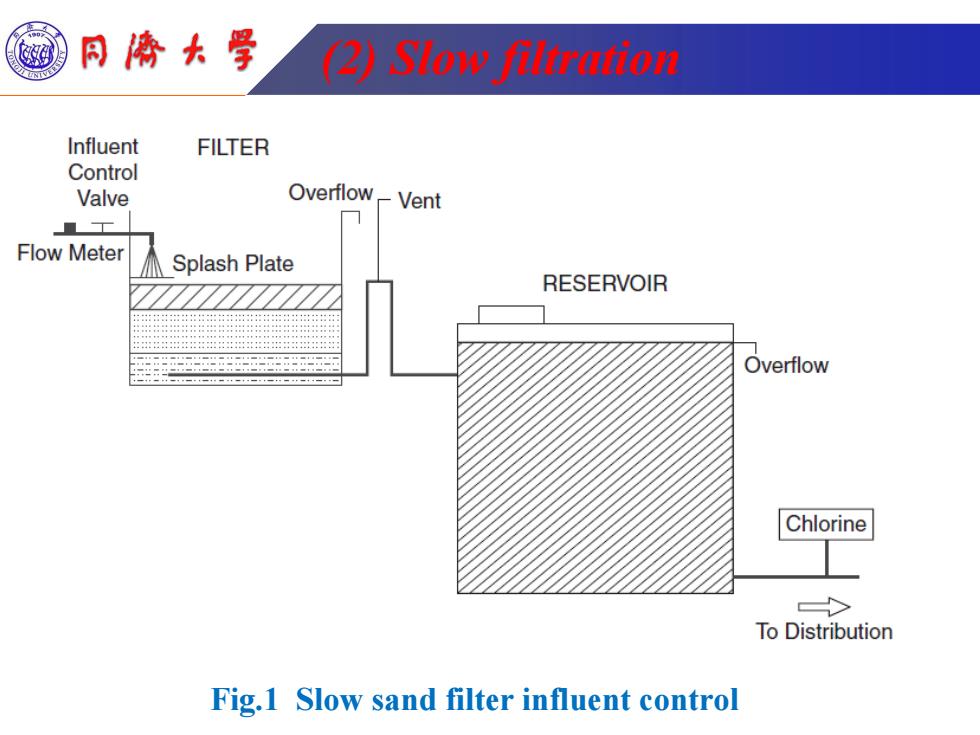
同©大学 2Sation Influent FILTER Control Valve Overflow -Vent Flow Meter Splash Plate RESERVOIR Overflow Chlorine To Distribution Fig.1 Slow sand filter influent control
Tongji University (2) Slow filtration Fig.1 Slow sand filter influent control
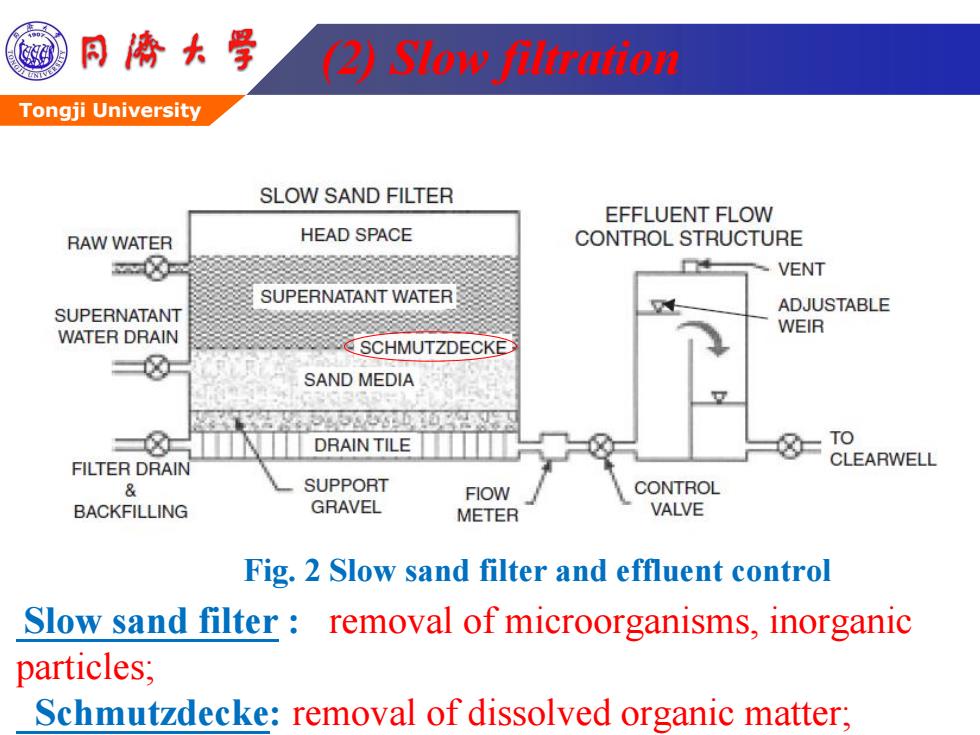
同©大学 2ation Tongji University SLOW SAND FILTER EFFLUENT FLOW RAW WATER HEAD SPACE CONTROL STRUCTURE VENT SUPERNATANT WATER SUPERNATANT ADJUSTABLE WATER DRAIN WEIR SCHMUTZDECKE SAND MEDIA DRAIN TILE TO FILTER DRAIN CLEARWELL & SUPPORT FIOW CONTROL BACKFILLING GRAVEL METER VALVE Fig.2 Slow sand filter and effluent control Slow sand filter removal of microorganisms,inorganic particles; Schmutzdecke:removal of dissolved organic matter;
Tongji University (2) Slow filtration Fig. 2 Slow sand filter and effluent control Slow sand filter : removal of microorganisms, inorganic particles; Schmutzdecke: removal of dissolved organic matter;

同海大学 inlet pipe used to introduce backwater for Tongji University sand cleaning filter gravel 3)Rapid filtration outlet under drain Replaced slow sand filters in 20th century; Much higher loading rate than slow sand filters,more than 100 X,typically 5-15 m/hour; Media are coarser,more uniform,(often multiple); Removal is not by physical straining on the surface as primary mechanism; Conceptually,rapid filtration is like sedimentation; Particles need pre-treatment with a coagulant to destabilize electrical charge;Destabilized particles adhere to grains in filter medium and are removed; Turbidity of outflow changes with time;
Tongji University (3) Rapid filtration • Replaced slow sand filters in 20th century; • Much higher loading rate than ; slow sand filters, more than 100 X, typically 5-15 m/hour; • Media are coarser, more uniform, (often multiple); • Removal is not by physical straining on the surface as primary mechanism; • Conceptually, rapid filtration is like sedimentation; • Particles need pre-treatment with a coagulant to destabilize electrical charge; Destabilized particles adhere to grains in filter medium and are removed; • Turbidity of outflow changes with time;
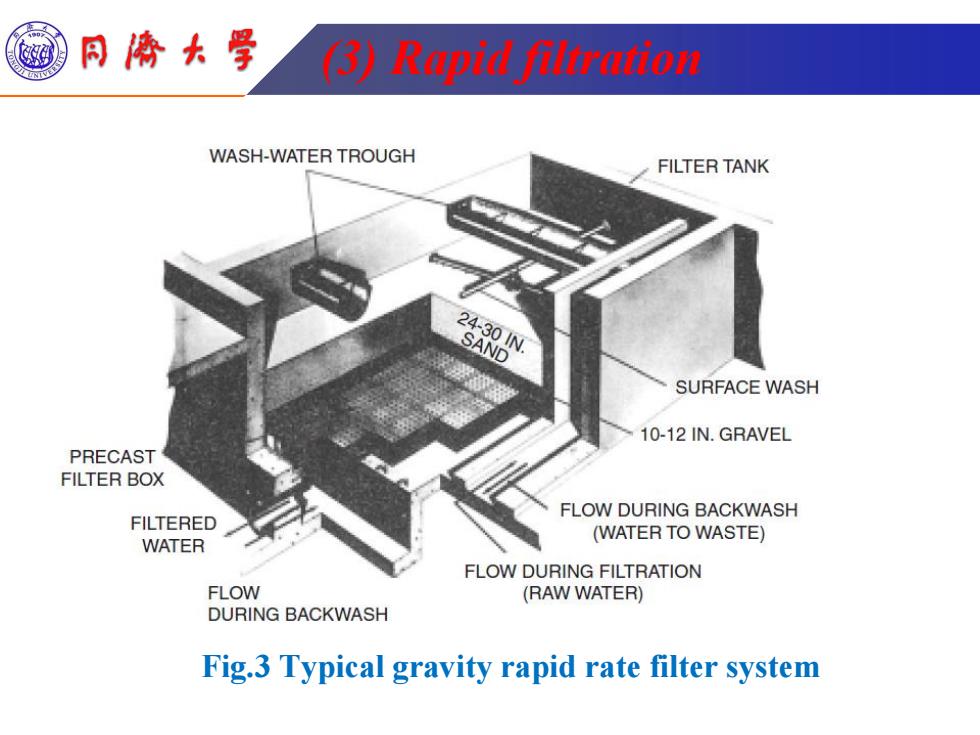
同燎大学 ③)ration WASH-WATER TROUGH FILTER TANK 24-301N. SAND SURFACE WASH 10-12 IN.GRAVEL PRECAST FILTER BOX FLOW DURING BACKWASH FILTERED WATER (WATER TO WASTE) FLOW DURING FILTRATION FLOW (RAW WATER) DURING BACKWASH Fig.3 Typical gravity rapid rate filter system
Tongji University (3) Rapid filtration Fig.3 Typical gravity rapid rate filter system

同©大学 ③ration Filter Influent Waste(or Spent)Filter Backwash(FBW) Water Above Filter Filter Media Filtration Rate Control Equal(Constant)Rate Underdrain Filter Effluent Declining Rate System Backwash Water Supply Filter to Waste (Backwash Air Supply) Fig.4 A typical gravity filter cross section
Tongji University (3) Rapid filtration Fig.4 A typical gravity filter cross section
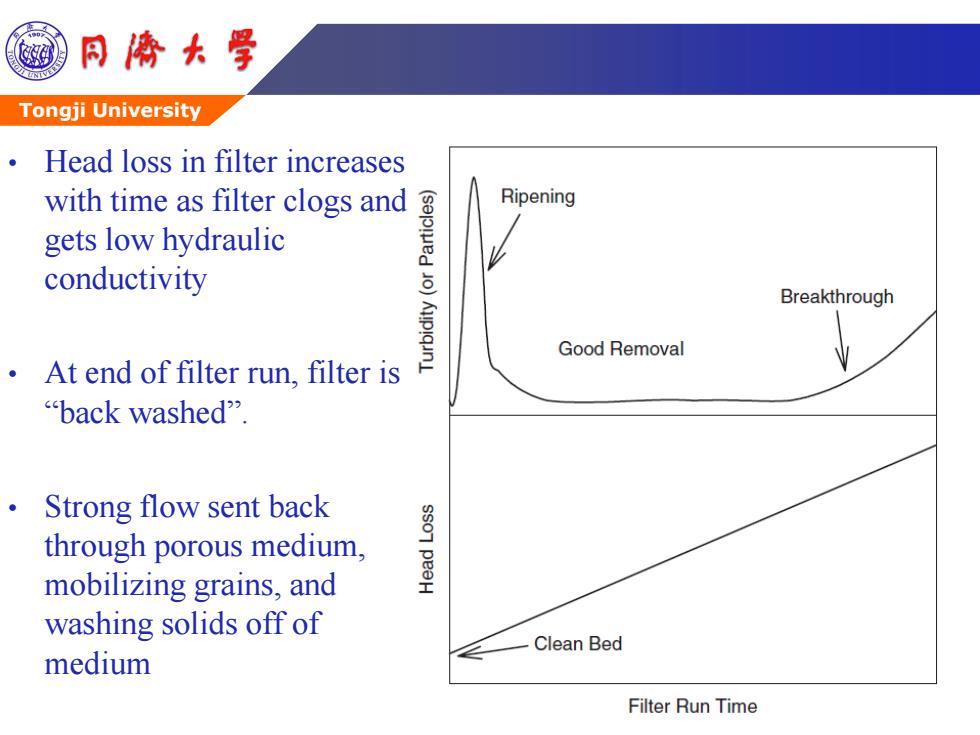
同海大学 Tongji University Head loss in filter increases with time as filter clogs and Ripening gets low hydraulic conductivity Breakthrough Good Removal At end of filter run,filter is "back washed". Strong flow sent back through porous medium, mobilizing grains,and washing solids off of Clean Bed medium Filter Run Time
Tongji University • Head loss in filter increases with time as filter clogs and gets low hydraulic conductivity • At end of filter run, filter is “back washed”. • Strong flow sent back through porous medium, mobilizing grains, and washing solids off of medium